We love garlic and onions – of all sorts, from white, yellow and red onions, to shallots, leeks, scallions, chives, you name it – but they don’t love us back. Possibly one of the first things you learn when you are introduced to the low FODMAP diet is that garlic and many types of alliums (onions) are high in fructans and strongly limited, especially during the Elimination Phase. Panic sets in. How are you going to cook? This article on Low FODMAP Garlic & Onion Substitutes shows you how to get all that onion and flavor you crave into your low FODMAP cooking with substitutes, while keeping IBS triggers at bay.
Please note that there are small serving sizes of garlic and onions themselves that are low FODMAP, and that is addressed in our article, Yes, You Can Eat Garlic and Onion on the Low FODMAP Diet—Here’s How.
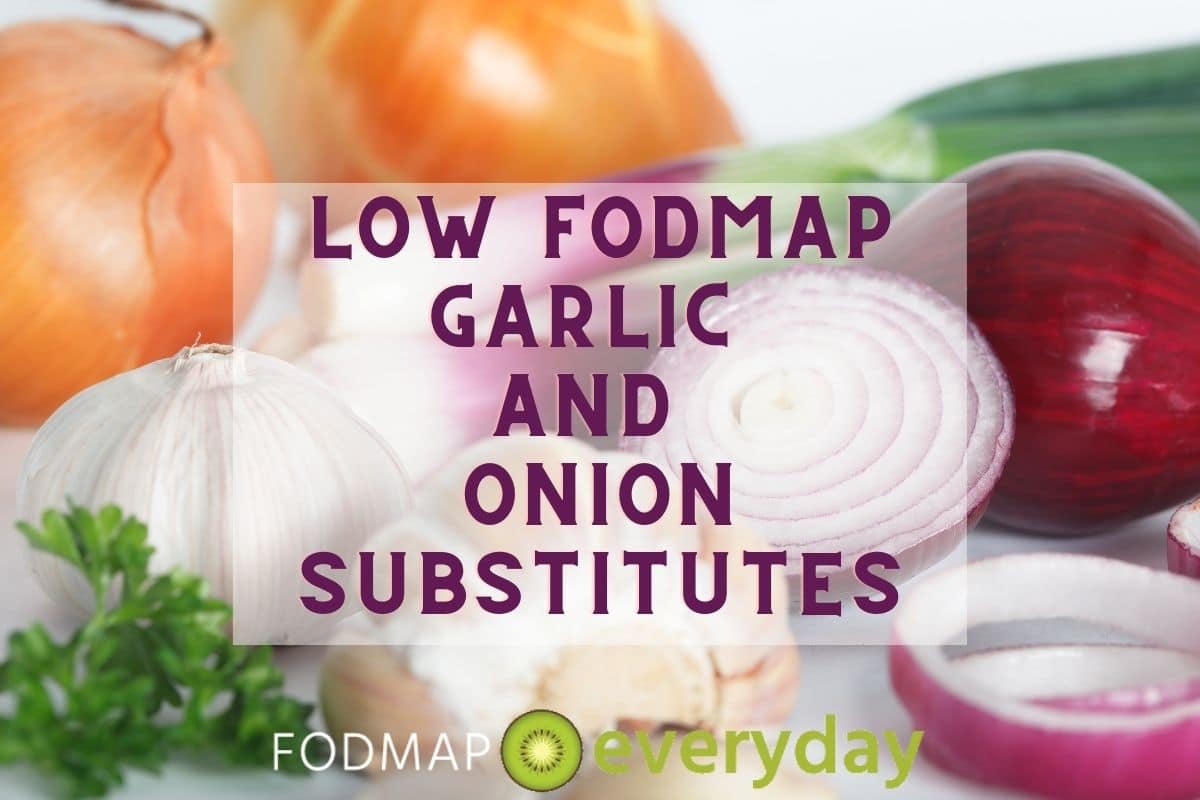
All of the information in this article is based upon lab tested, evidence-based science from Monash University and FODMAP Friendly.
- Garlic-Infused Oil, Butter & Ghee
- What is Garlic-Infused Oil?
- Is Garlic-Infused Oil Low FODMAP?
- How Can I Make Garlic-Infused Oil?
- What About Acidified Garlic-Infused Oil?
- Can I Make Low FODMAP Garlic-Infused Oil With Any Oil?
- Can I Make Garlic-Infused Butter?
- Can I Make Garlic-Infused Ghee?
- Where Can I Find Garlic-Infused Oil?
- How Do I Use Garlic-Infused Oil? And Onion-Infused oil?
- Fresh Garlic Scapes
- Asafetida
- Prepared Low FODMAP Garlic & Onion Products
- What Is Garlic Scape Powder?
- Is Garlic Scape Powder Low FODMAP?
- What Does Garlic Scape Powder Taste Like?
- How Do I Use Garlic Scape Powder?
- Where Can I Buy Garlic Scape Powder?
- Can I Make Garlic Scape Powder?
- What Is Garlic Chive Powder?
- Is Garlic Chive Powder Low FODMAP?
- What Does Garlic Chive Powder Taste Like?
- How Do I Use Garlic Chive Powder?
- Where Can I Buy Garlic Chive Powder?
- Can I Make Garlic Chive Powder?
- What Is Green Onion Powder?
- Is Green Onion Powder Low FODMAP?
- What Does Green Onion Powder Taste Like?
- How Do I Use Green Onion Powder?
- Where Can I Buy Green Onion Powder?
- Can I Make Green Onion Powder?
- Is Garlic Powder Low FODMAP?
- Is Onion Powder Low FODMAP?
- What Is Low FODMAP Garlic Powder?
- What Is Low FODMAP Onion Powder?
- Is Garlic Salt Low FODMAP?
- Is Onion Salt Low FODMAP?
- What Is Low FODMAP Garlic Salt?
- What Is Low FODMAP Onion Salt?
- More On Garlic & Onions
- The Takeaway
Garlic-Infused Oil, Butter & Ghee
For many people, when they begin the diet, they hear that they can use garlic-infused oil, but they do not understand why, or how to make or buy it. And what about infused butter and ghee? Here is what you need to know:
What is Garlic-Infused Oil?
True garlic-infused oil is made from steeping fresh garlic in oil (any kind of pure oil). Our recipe for Low FODMAP Garlic-Infused Oil suggests very gently heating the garlic and oil – and not simmering, which we believe creates an acrid taste. All of the garlic solids are then removed from the oil, and you are left with “garlic-infused oil”. The same technique can be used for onions, and you can even combine garlic and onions.
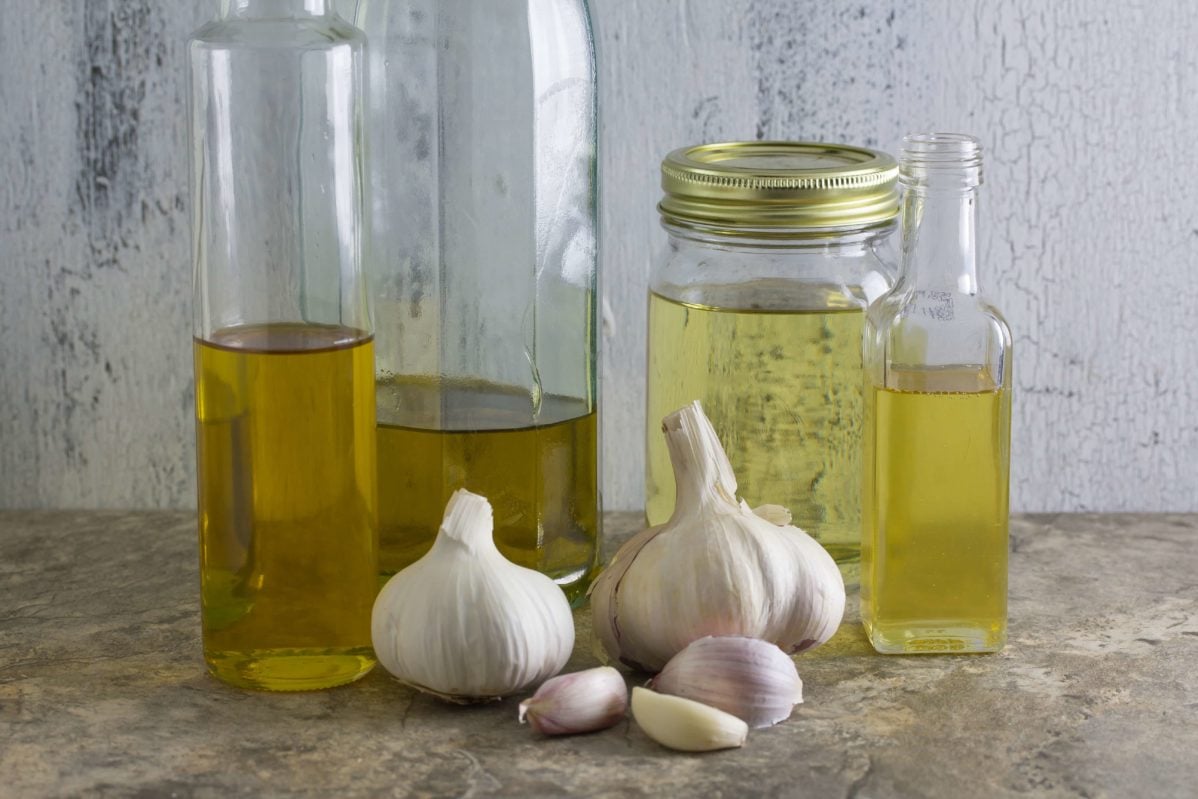
The fructans in garlic and onion are water soluble, but not oil soluble. Their flavor remains in the oil, but without any FODMAPs. There are several “garlic-infused” oils that have been lab tested and certified, and you can also read labels.
Is Garlic-Infused Oil Low FODMAP?
Not all “garlic-infused” oils are low FODMAP. Note the use of the quotes. This is because many– probably the majority – of prepared flavored oils on the market that call themselves infused, are not actually infused.
Infusing is a technical culinary term, but it is also a word used to describe things that are enhanced by something else. Like, one might say, the room was infused with a lovely fragrance. When it comes to food, infusing an oil would take place as described in the above section.
The fructans in garlic and onion are water soluble, but not oil soluble. Their flavor remains in the oil, but without any FODMAPs.
Many prepared flavored oils calling themselves “infused” use natural garlic flavoring, essential oils and even artificial flavors to lend the garlic flavor to the oil. Some of these might be low FODMAP and some might not be. Then there are those that still have garlic bits within the bottle; steer clear of those. Please read our article, Know What’s In Your Garlic Oil.
If you stick with lab tested and certified products, such as Fody Garlic Infused Olive Oil and their Fody Shallot Infused Olive Oil you will have assurance.
How Can I Make Garlic-Infused Oil?
We have the best Low FODMAP Garlic-Infused Oil recipe. It is simple, yields excellent results, and you can even vary the garlic strength by increasing or decreasing the amount of garlic that you use. Our recipe assumes that you want to make a big batch and store it.
What if you have none at hand and need it? There is another way to make low FODMAP garlic-infused oil on the fly. Simply add oil to your pot, add your roughly chopped garlic, and sauté for a few minutes. Remove all the garlic solids and you are ready to make your chosen dish.
What About Acidified Garlic-Infused Oil?
We have an article and recipe for acidified oil. While you can make it, we do not think it is worth the bother; the article explains why.
Can I Make Low FODMAP Garlic-Infused Oil With Any Oil?
Yes, you can make Low FODMAP Garlic-Infused Oil with any pure oil – canola, olive, sunflower, avocado, peanut, coconut, etc.
Can I Make Garlic-Infused Butter?
Butter contains about 15% to 18% water; the fructans in garlic are water soluble, so they could leach into the melted butter. We do not recommend using butter.
Can I Make Garlic-Infused Ghee?
Water is removed from butter when making ghee, but there is no way to know if you have removed all of the water content. We advise against this.
Where Can I Find Garlic-Infused Oil?
Of course, you can make your own and we think our garlic version and onion version are exemplary. If you want to purchase, we have two articles for you to read, one with several brand recommendations and one diving deep into how not all “infused” oils are created equal. Here we will simply give you our favorite lab tested and certified low FODMAP recommendations and one, that while it is not lab tested, is low FODMAP and is our favorite vegetable oil based.

By the way, we suggest you keep olive oil based and vegetable oil based infused oils on hand, because they each have their preferred usages.
Lab tested certified low FODMAP flavored oils:
- Colavita Roasted Garlic Extra Virgin Olive Oil
- Cobram Estate Garlic Infused Extra Virgin Olive Oil
- Cobram Estate Roasted Onion Infused Extra Virgin Olive Oil
- Cobram Estate Garlic & Onion Infused Extra Virgin Olive Oil
- Cobram Estate Garlic & Rosemary Infused Extra Virgin Olive Oil
- Fody Garlic Infused Olive Oil
- Fody Shallot Infused Olive Oil
The following are not lab tested or certified, but they are low FODMAP.
- Boyajian Garlic Oil
- La Tourangelle Garlic-Infused Oil (sunflower oil based)
If you buy prepared flavored oils, they will be safe for consumption. They will have preservatives added, such as citric acid, or the garlic itself might have been acidified during the preparation process, and/or they are pasteurized upon bottling.
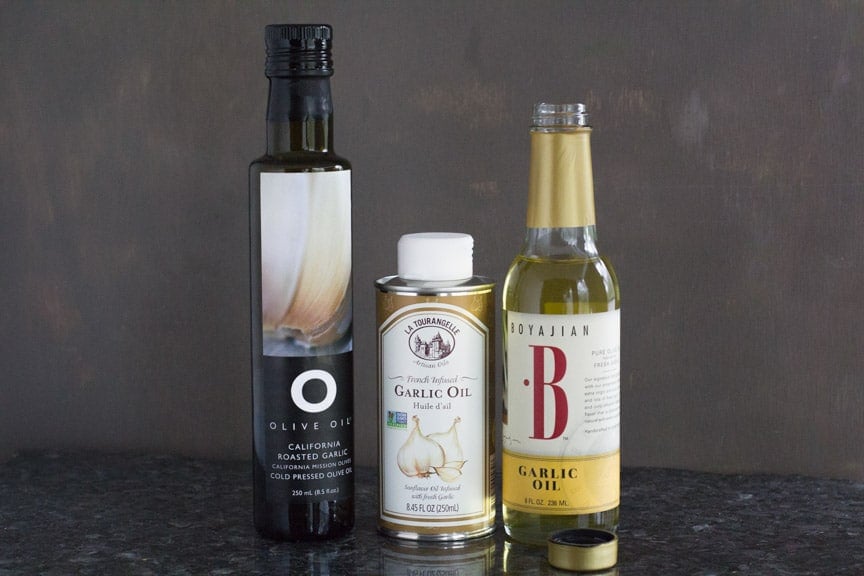
The danger with homemade infused oils is the risk of botulism poisoning, which can occur if freshly made infused oils are not handled properly. You will see in our Low FODMAP Garlic-Infused Oil recipe and our Low FODMAP Onion-Infused Oil recipe that we suggest storing in the refrigerator and using within 3 days or freeze for longer storage. These directions are based on governmental safety guidelines, and we stick to them.
Yes, we have heard all the stories about folks letting garlic steep in oil for days and days at room temp on the windowsill and the like, and no one ever getting sick. But there is the chance of bacterial growth; why risk it? You have enough going on with your gut!
How Do I Use Garlic-Infused Oil? And Onion-Infused oil?
So many recipes call for heating oil in a pan, adding garlic and/or onions and then going on to make your recipe, adding vegetables, proteins and grains; this approach would yield a high FODMAP result as ANY additional ingredients other than the pure oil do have a water content. Fructans, being water soluble will leach into the dish. You CANNOT just fish out the garlic and onions later after you have made your dish.
You can make your recipe simply by starting with garlic-infused oil or onion-infused-oil and proceeding to great, and very similar, results.
Fresh Garlic Scapes
What Are Garlic Scapes?
Garlic scapes are the shoots that sprout from the tops of garlic bulbs.
Are Garlic Scapes Low FODMAP?
Yes, garlic scapes are low FODMAP. On the Monash University app, they are called “garlic shoots”. They have been lab tested and fresh garlic scapes/shoots have a low FODMAP serving size of 30 g (updated to 33 g) or about 6 Australian tablespoons. They quickly become Moderate for fructose and fructans at 40 g.
Where Can I Find Fresh Garlic Scapes?
We only see them at farmers markets or in friend’s gardens. Make friends with your gardening neighbors!
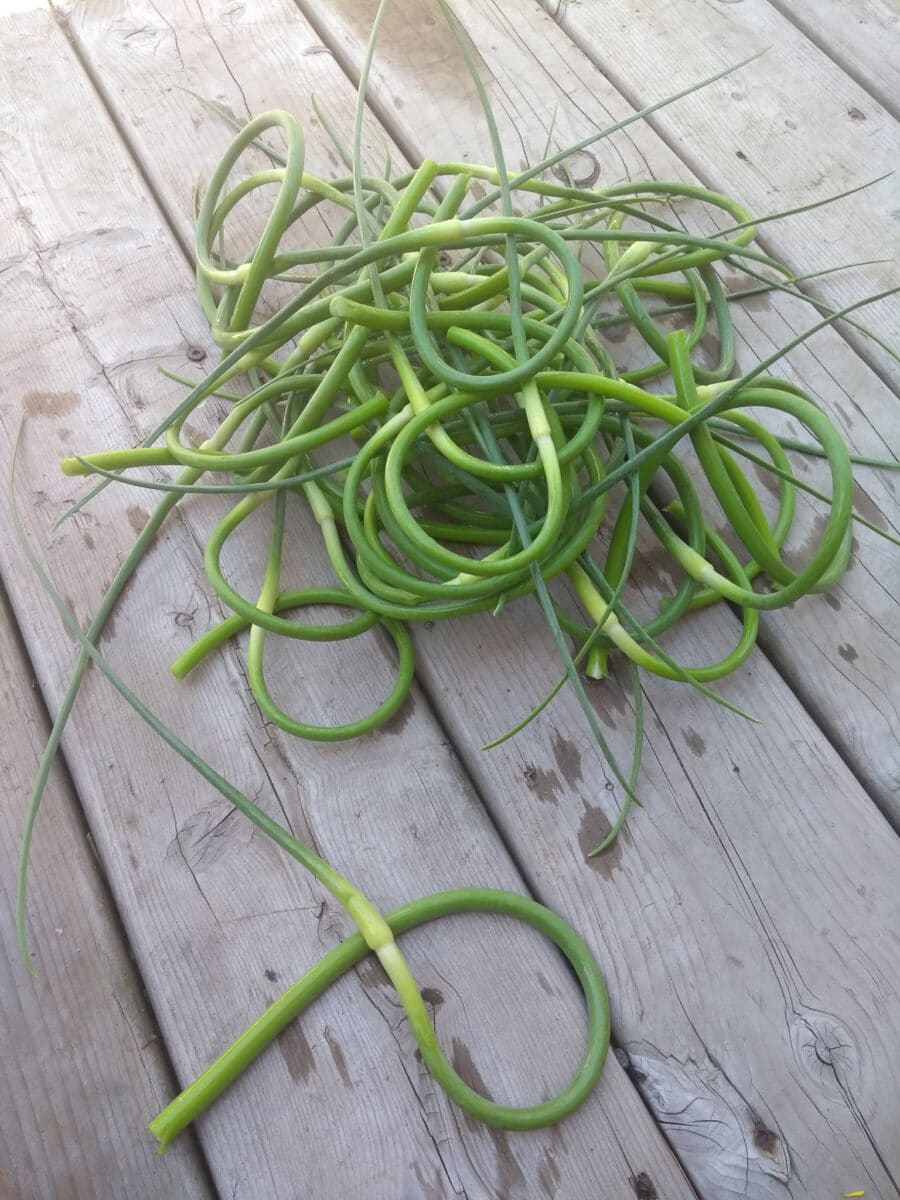
How Do I Use Fresh Garlic Scapes?
You can chop fresh garlic scapes, similarly to the way you would prep scallion greens, and use them fresh or raw in your chosen recipes.
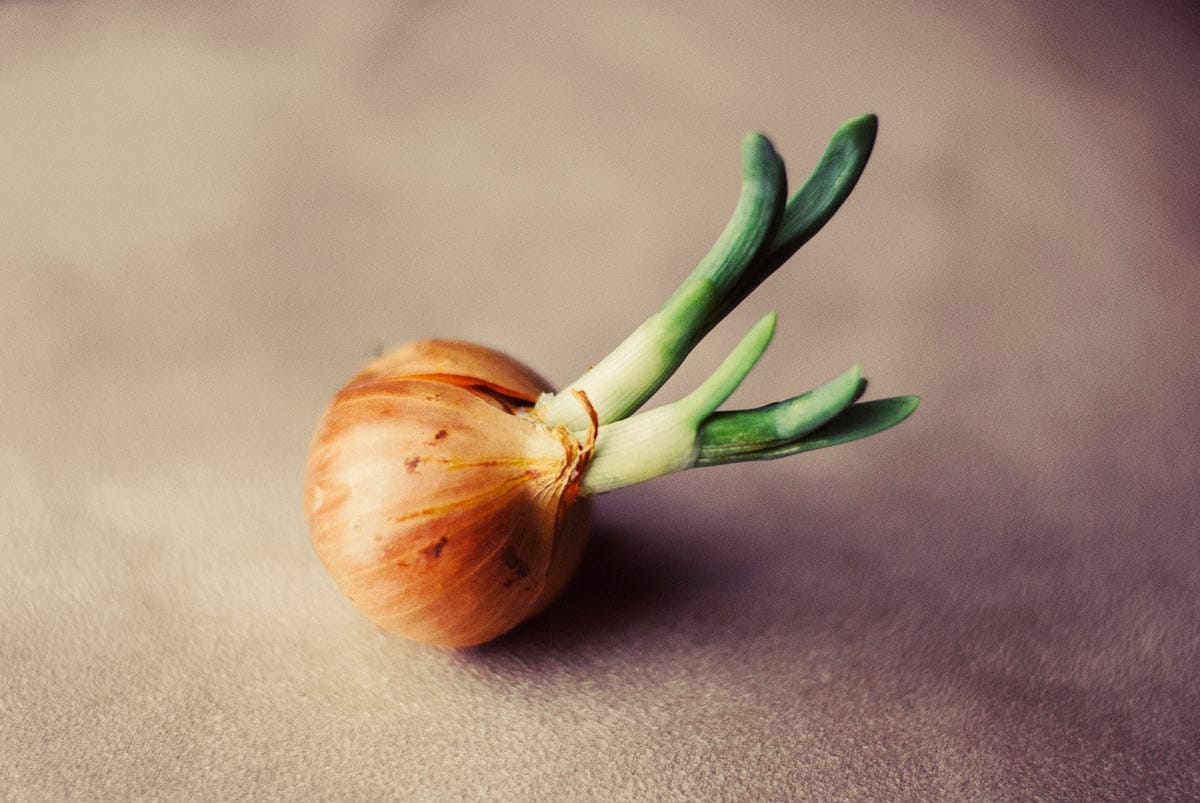
Can I Eat Onion Shoots?
Onion shoots, which are the green shoots that emerge from the tops of onions, and might seem similar to garlic scapes/shoots, have not been lab tested and should be treated as such. Read our article, What If A Food Hasn’t Been Lab Tested For FODMAPs?
Asafetida
What Is Asafetida?
Also spelled “asafoetida” as it is on the Monash University app, this is a dried gum extracted from ferula, which is an herb related to celery; asafetida is also called “hing”. Asafoetida powder is used as a spice or flavoring agent, very commonly found in Indian cooking. Note that its smell is quite pungent, but once used in a cooked dish, it mellows out and provides an oniony garlicky flavor.
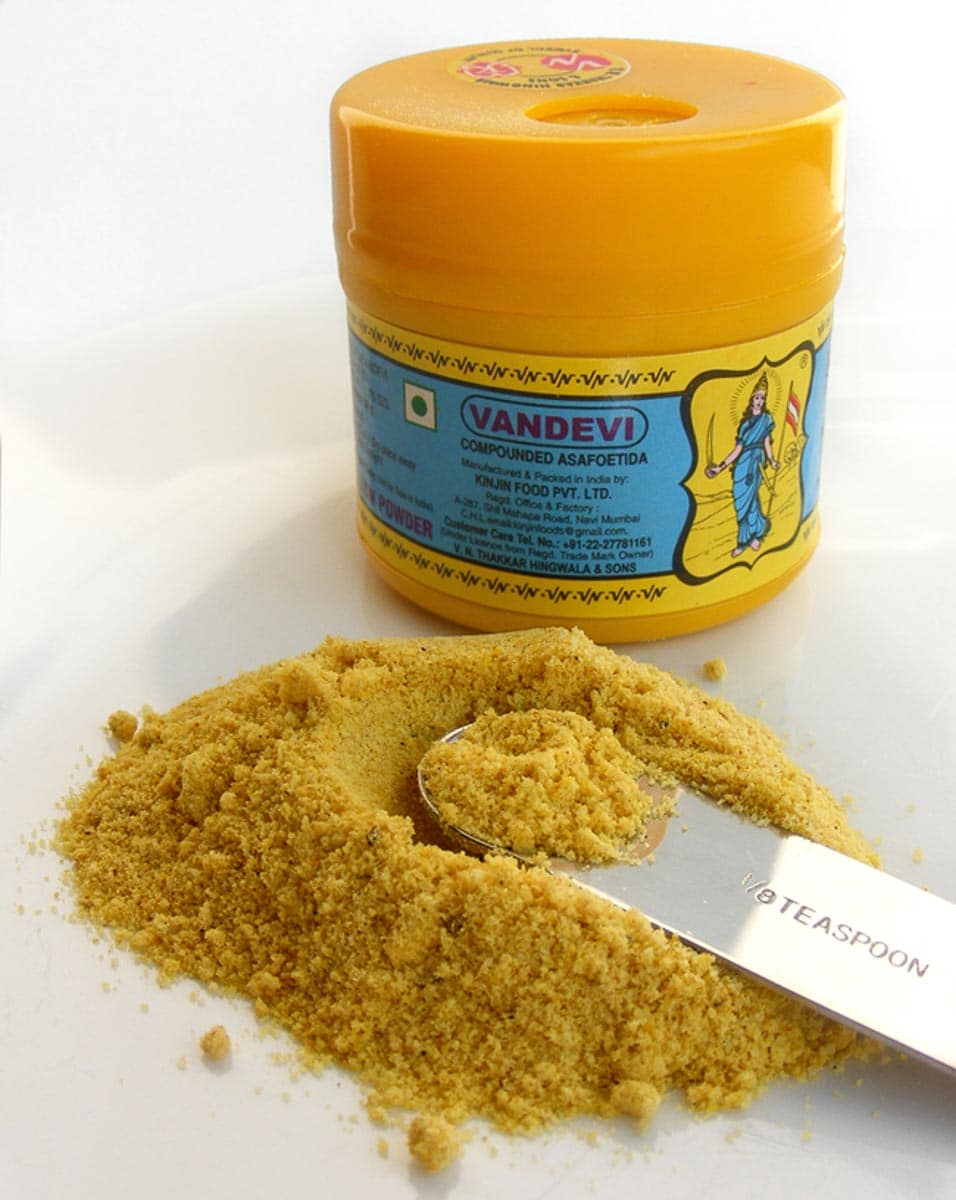
Is Asafetida Low FODMAP?
Yes, asafetida powder is low FODMAP. It has been lab tested by Monash University and the recommended serving size is 2 g, or ¼ teaspoon. Please note that some asafetida is packaged with an amount of wheat flour. Monash has not disclosed whether the kind tested contained wheat, or not. The low FODMAP diet is not a wheat free diet but at the very least consider hing to contain wheat and gluten, so it is not recommended for celiacs.
Is Asafoetida Safe To Eat?
Asafetida is considered safe to eat for most people, however, there is some evidence that larger amounts can have a negative effect on those who are pregnant. Best to avoid at those times. Please consult your doctor or RD before consuming, if pregnant or trying to become pregnant.
How Do I Use Asafetida?
Best results are achieved if you bloom a small amount in warm oil, as you would with curry powder. Then you can go on to make your dish, adding other ingredients. Do not be put off by the pungent smell when raw; it will mellow out when cooked.
Prepared Low FODMAP Garlic & Onion Products
We mentioned prepared infused oils above, but will mention here again, along with other products that will bring onion and garlic flavor to your low FODMAP cooking. Those that are lab tested and certified low FODMAP are labeled as such.
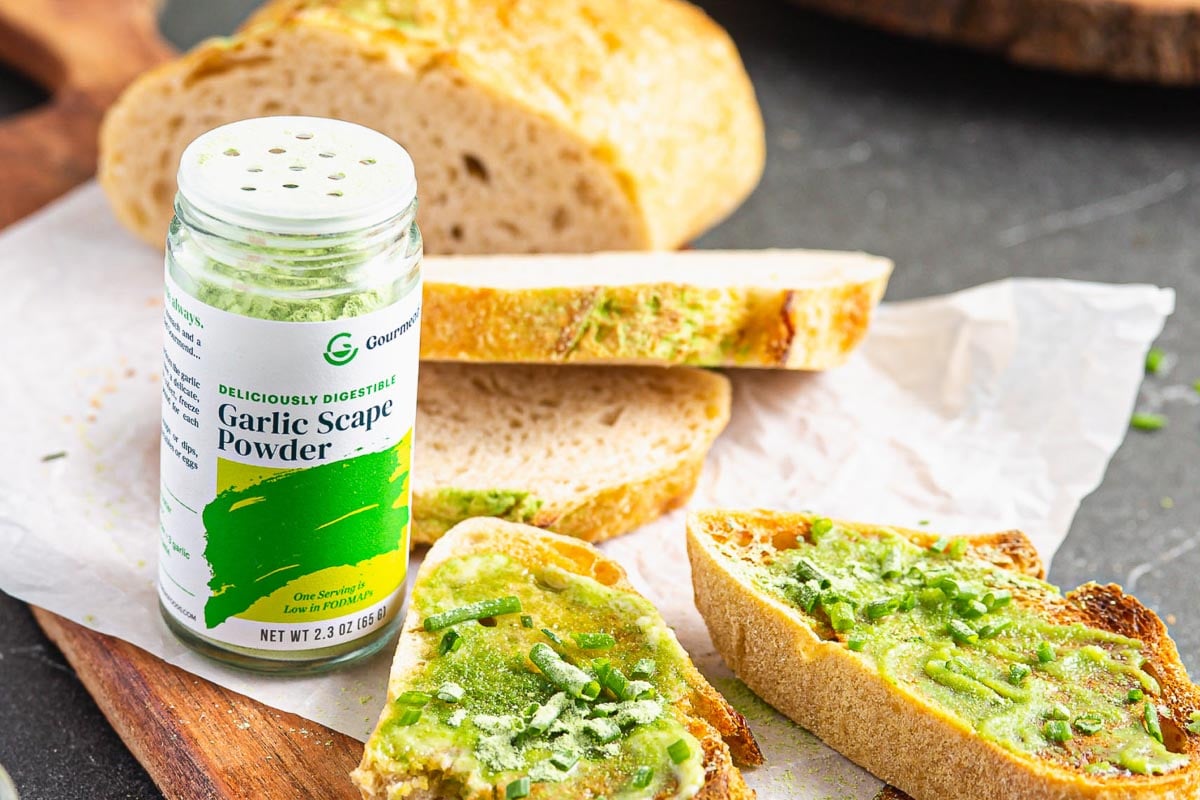
What Is Garlic Scape Powder?
Garlic Scape Powder has been brought to market by Gourmend, a company specializing in low FODMAP products. It is a very pure product and is made from ground dehydrated and dried garlic scapes.
Is Garlic Scape Powder Low FODMAP?
Gourmend Garlic Scape Powder has been lab tested and certified low FODMAP by Monash University in serving sizes of ¼ teaspoon or .3 g. Larger serving sizes of .6 g or more contain high FOMDAP amounts of fructans.
What Does Garlic Scape Powder Taste Like?
Gourmend Garlic Scape Powder has a mild garlic flavor.
How Do I Use Garlic Scape Powder?
The makers of Gourmend Garlic Scape Powder suggest incorporating the powder into cooked dishes, as opposed to using it raw. Use as you would any other dried herb or spice.
Where Can I Buy Garlic Scape Powder?
We have Gourmend Garlic Scape Powder available in our store and you can also go directly to their website.
Can I Make Garlic Scape Powder?
You could dry garlic scapes and grind them to a powder but there is no way to know if your result would be low FODMAP. Processing of all sorts, including dehydrating, drying, freeze-drying, etc. can dramatically alter FODMAPs and there is no way to know FODMAP content without lab testing.
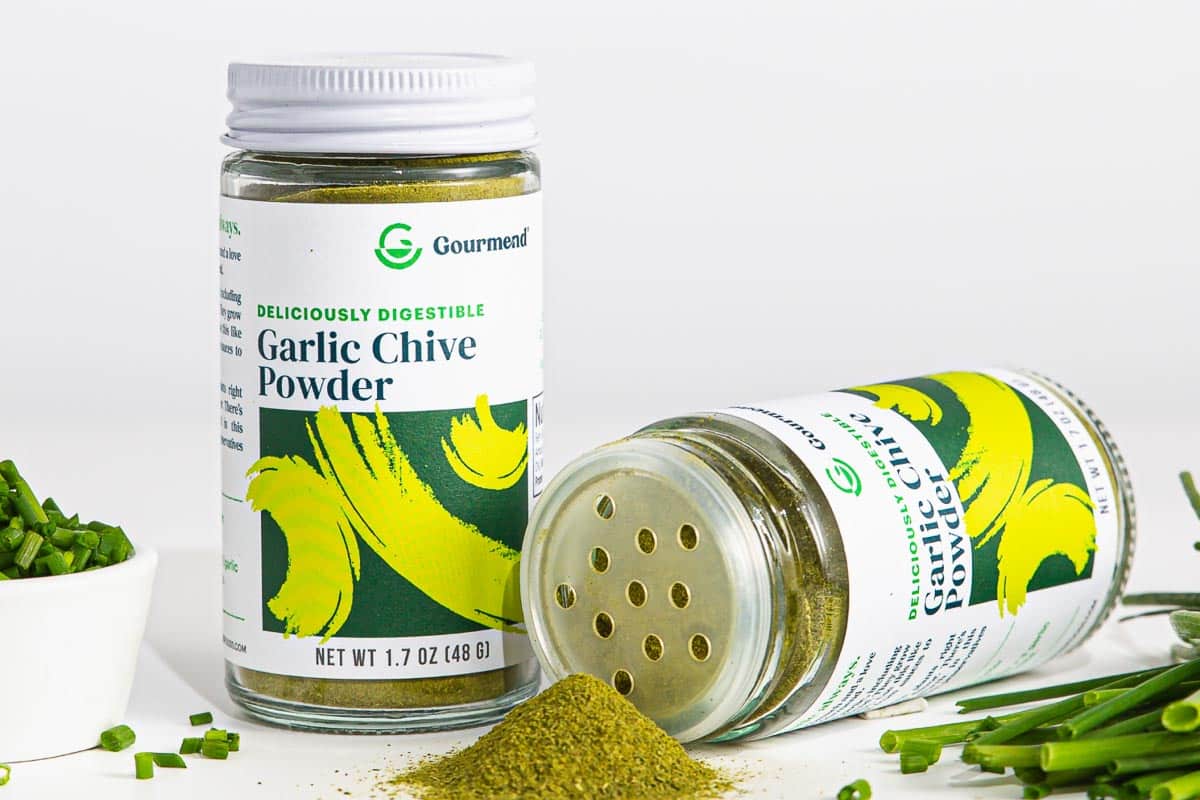
What Is Garlic Chive Powder?
Garlic Chive Powder has been brought to market by Gourmend, a company specializing in low FODMAP products. It is a very pure product and is made from ground dehydrated and dried garlic chives.
Is Garlic Chive Powder Low FODMAP?
Gourmend Garlic Chive Powder has been lab tested and certified low FODMAP by Monash University in serving sizes of ¼ teaspoon or .5 g. Always bear in mind that serving sizes are connected to government guidelines and do not necessarily indicate that this is the upper level for FODMAP intake. Always check the small print in the Monash University Low FODMAP Diet app; in this case it states that “only trace amounts of FODMAPs were detected” in this product, and to “eat freely and according to appetite”.
What Does Garlic Chive Powder Taste Like?
Gourmend Garlic Chive Powder has a mild onion flavor.
How Do I Use Garlic Chive Powder?
The makers of Gourmend Garlic Chive Powder suggest incorporating the powder into cooked dishes, as opposed to using it raw. Use as you would any other dried herb or spice.
Where Can I Buy Garlic Chive Powder?
We have Gourmend Garlic Chive Powder available in our store and you can also go directly to their website.
Can I Make Garlic Chive Powder?
You could dry garlic chives and grind them to a powder but there is no way to know if your result would be low FODMAP. Processing of all sorts, including dehydrating, drying, freeze-drying, etc. can dramatically alter FODMAPs and there is no way to know FODMAP content without lab testing.
What Is Green Onion Powder?
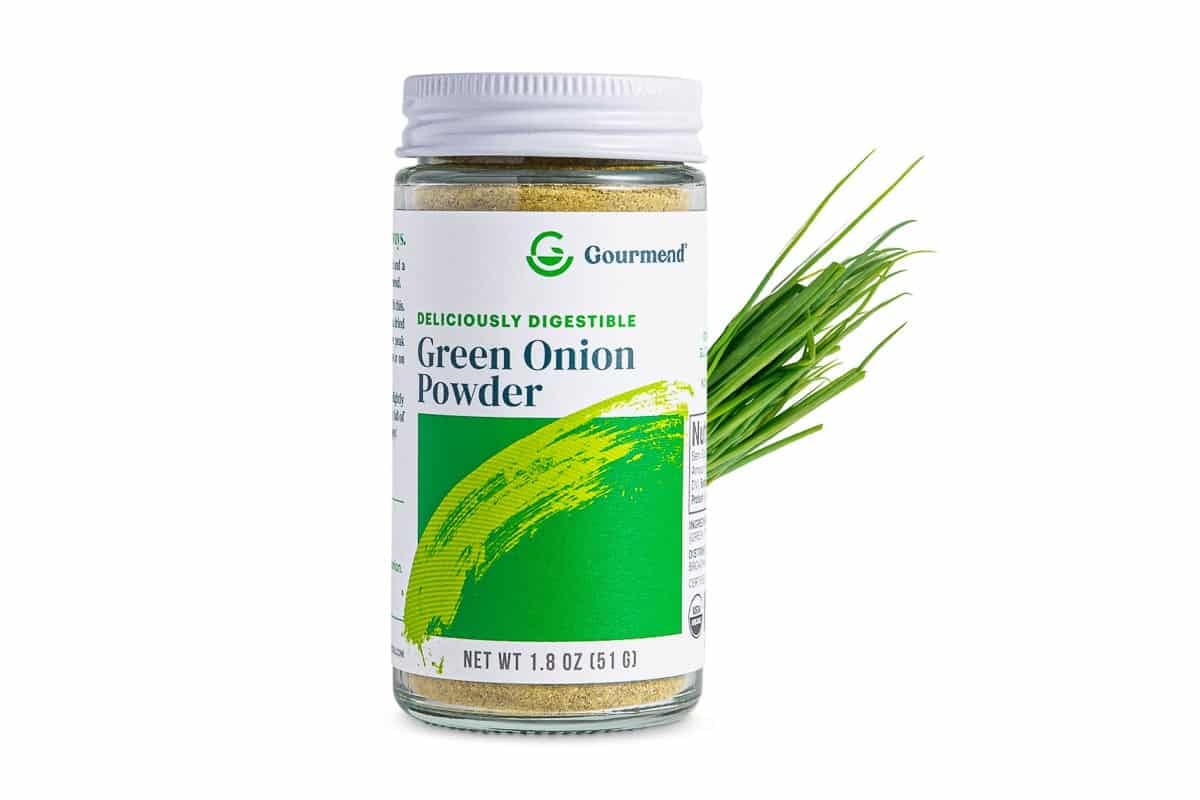
Green Onion Powder has been brought to market by Gourmend, a company specializing in low FODMAP products. It is a very pure product and is made from ground dehydrated and dried green onion tops/leaves.
Is Green Onion Powder Low FODMAP?
Gourmend Green Onion Powder has been lab tested and certified low FODMAP by Monash University in serving sizes of ¼ teaspoon or .4 g.
What Does Green Onion Powder Taste Like?
Gourmend Green Onion Powder has a mild onion flavor.
How Do I Use Green Onion Powder?
The makers of Gourmend Green Onion Powder suggest incorporating the powder into cooked dishes, as opposed to using it raw. Use as you would any other dried herb or spice.
Where Can I Buy Green Onion Powder?
We have Gourmend Green Onion Powder available through our shop and you can also go directly to their website.
Can I Make Green Onion Powder?
You could dry green onion tops and grind them to a powder but there is no way to know if your result would be low FODMAP. Processing of all sorts, including dehydrating, drying, freeze-drying, etc. can dramatically alter FODMAPs and there is no way to know FODMAP content without lab testing.
Is Garlic Powder Low FODMAP?
Conventional garlic powder, made from dried/dehydrated garlic, is high FODMAP.
Is Onion Powder Low FODMAP?
Conventional onion powder, made from dried/dehydrated onion, is high FODMAP.
What Is Low FODMAP Garlic Powder?
There are dry, granular products on the market that are very similar to conventional garlic powder, but they are low FODMAP. The conventional kind is made from dried/dehydrated garlic that has been finely ground to a powder and is high FODMAP.
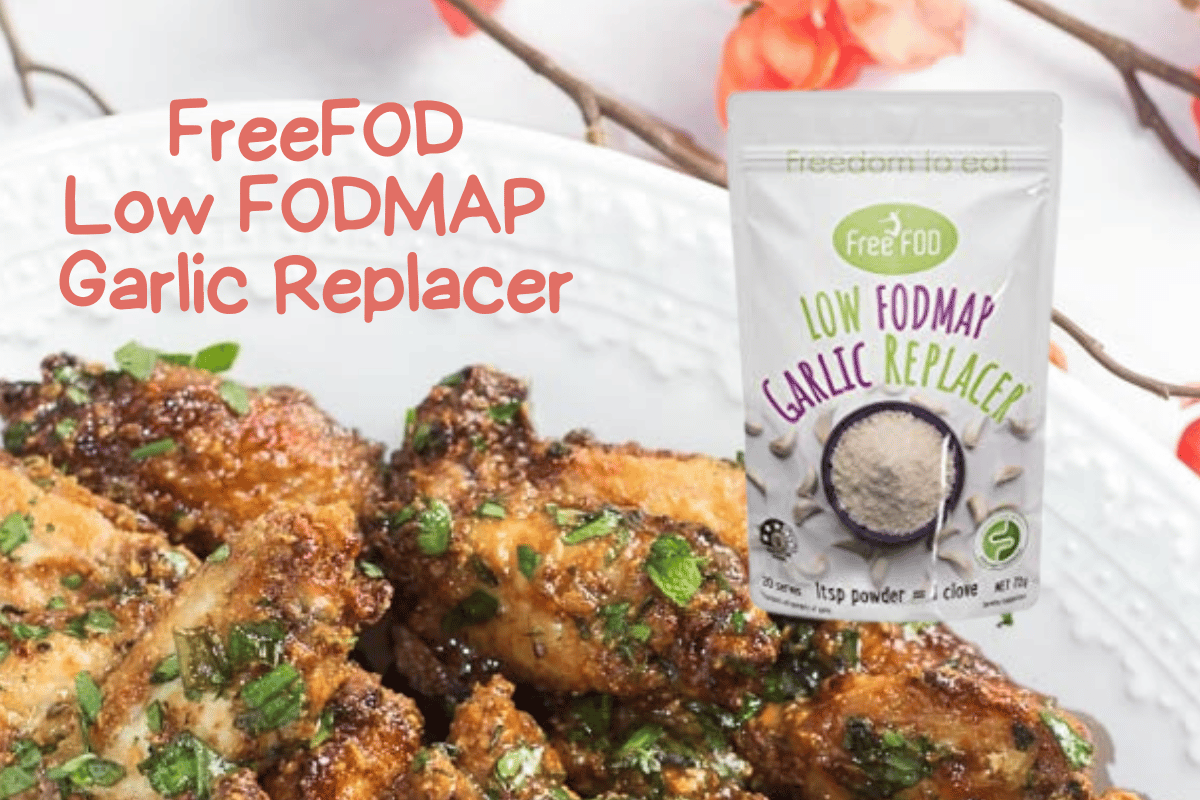
The low FODMAP versions are made from maltodextrin and natural garlic flavor. The FreeFod Garlic Replacer is lab tested and certified low FODMAP by FODMAP Friendly.
The Fodmazing Garlic Replacer Substitute contains the same ingredients but is not certified; it is also much less expensive. These low FODMAP garlic powders have been game changers for us, and we use them as we would conventional garlic powder, with one caveat. They tend to clump if added to fat or oil, so best dissolved in water-based ingredients.
Even thought the packages suggest that 1 teaspoon is equal to 1 clove of garlic, I find that I use about one-quarter
What Is Low FODMAP Onion Powder?
There are dry, granular products on the market that are very similar to conventional onion powder, but they are low FODMAP. The conventional kind is made from dried/dehydrated onion that has been finely ground to a powder and is high FODMAP.
The low FODMAP versions are made from maltodextrin and natural onion flavor. The FreeFod Onion Replacer is lab tested and certified low FODMAP by FODMAP Friendly. The Fodmazing Onion Replacer Substitute contains the same ingredients but is not certified; it is also much less expensive. These low FODMAP onion powders have been game changers for us, and we use them as we would conventional onion powder, with one caveat. They tend to clump if added to fat or oil, so best dissolved in water-based ingredients.
Is Garlic Salt Low FODMAP?
Conventional garlic salt is high FODMAP and contains dried/dehydrated garlic.
Is Onion Salt Low FODMAP?
Conventional onion salt is high FODMAP and contains dried/dehydrated onion.
What Is Low FODMAP Garlic Salt?
Smoke ‘n Sanity has a product called Essence of Garlic Salt that is lab tested and certified low FODMAP by Monash University. It contains salt, modified corn starch, natural flavors and the label notes that is “Contains: Alliums”.
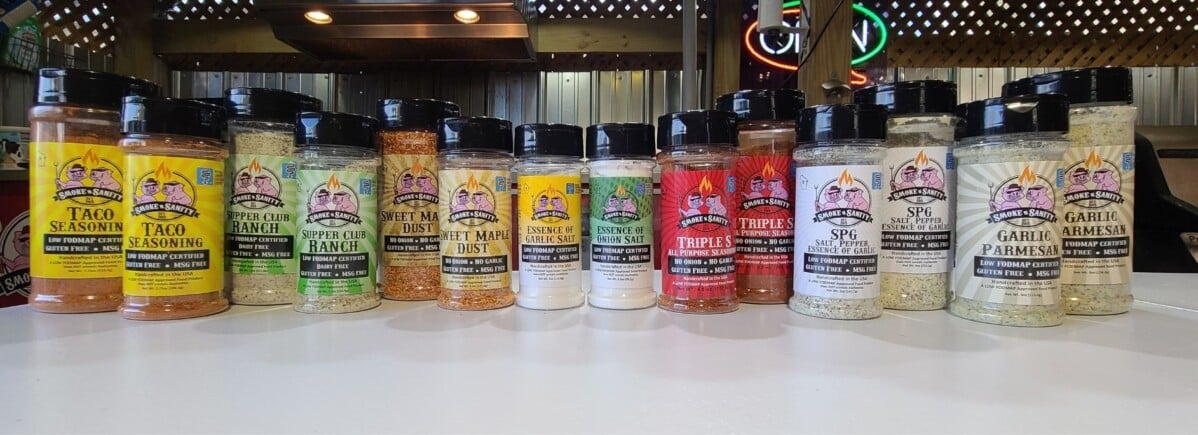
What Is Low FODMAP Onion Salt?
Smoke ‘n Sanity has a product called Essence of Onion Salt that is lab tested and certified low FODMAP by Monash University. It contains salt, modified corn starch, natural flavors and the label notes that is “Contains: Alliums”.
More On Garlic & Onions
If you are looking to learn more about garlic and onions, and their relationship to the low FODMAP diet, please check out the following:
- Yes, You Can Eat Garlic and Onion on the Low FODMAP Diet—Here’s How
- Not All Garlic-Infused Oil Is Low FODMAP
- Garlic-Infused Oil & The Low FODMAP Diet
- Get Your Garlic Fix on the Low FODMAP Diet
- Explore An Ingredient: Garlic
- Explore An Ingredient: Leeks
- Explore An Ingredient: Scallions
- All About Garlic Scapes and Garlic Chives
- Low FODMAP Garlic-Infused Oil
- Low FODMAP Onion-Infused Oil
- Low FODMAP Acidified Garlic Oil
- Know What’s In Your Garlic Oil
- Low FODMAP Aioli
The Takeaway
No need to go without garlic or onion flavor while following the low FODMAP diet. There are many fresh and prepared garlic and onion flavored ingredients that you can use in your low FODMAP cooking, even during the Elimination Phase.
Garlic and onion infused oils are a mainstay and can homemade or purchased. Newer to the market are “low FODMAP garlic powder” and “low FODMAP onion powder”. These can be used similarly to conventional garlic and onion powders but are low FODMAP. The Freefod brand are lab tested and certified low FODMAP by FODMAP Friendly.
And remember, the goal of the low FODMAP diet is to eventually eat as broadly as possible without triggering IBS symptoms. When you are in your Challenge Phase, be sure to try garlic, onions and all sorts of alliums to determine what your tolerance is. And if you cannot tolerate them right away, try Challenging yourself again several months down the line; you might be pleasantly surprised. Please do read our article, Yes, You Can Eat Garlic and Onion on the Low FODMAP Diet—Here’s How.
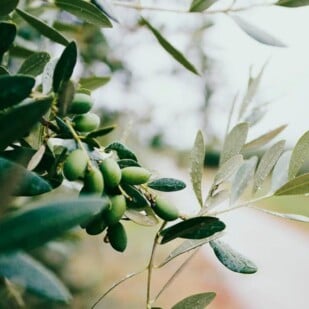
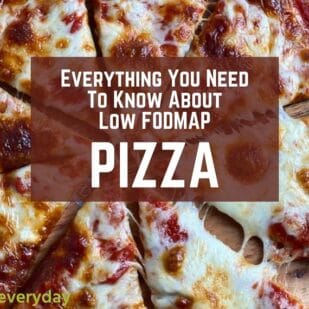






The leek leaves actually works I can now have onion taste in my food without being afraid I may have get used to it but it was awesome and I can also regrow the the leek leaves when ever I want flavor in my dishes this website has really good info
Thank you James! Happy cooking:)
Re: garlic scapes. In the U.S. (Northern Hemisphere?), garlic scapes are available for a short time say, March through early June, south to north. I have ordered them from garlic farmers on the internet. They are not cheap, but mine came quickly and were still very fresh when they arrived. I chopped and froze them to use in cooking.